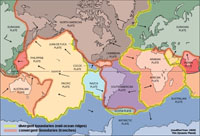4.2: Plate Tectonics Theory
- Page ID
- 9849
Plate Tectonics Theory
Today, Plate Tectonics Theory explains the large-scale motions of Earth's lithosphere. Plate tectonics theory builds on concepts of "continental drift." It was the global efforts of seafloor exploration following World War II resulted in the development of seafloor spreading theories in the late 1950s and early 1960s. This exploration effort involved perhaps many thousands of scientists within the "global geoscience community" (geologists, oceanographers, paleontologists, and geophysicists, assisted by world leaders) who systematically gathered information and mapped the world, both on land and underwater. The mechanics of Plate Tectonics Theory were largely resolved as large quantities of data about the age and distribution of rocks beneath the ocean basins were compiled from ocean drilling programs and geophysical studies of the ocean crust from around the world. Seafloor mapping, along with the study of volcanoes and earthquakes provided the evidence to support plate tectonics theory.
Plate Tectonics Theory helps to explains to some degree almost "all things geological" in the observable world, past and present. Plate tectonics expounds that Earth’s outer shell (lithosphere) is composed of several large, thin, relatively rigid “plates” that move relative to one another. Movements along fault systems that define Lithospheric plate boundaries produce most observed earthquakes.

Figure 4.6. Map showing the location of lithospheric plates and plate boundaries of the world. Boundaries shown in yellow are divergent boundaries, Those in orange are convergent boundaries. Note that some plates include both continental and oceanic crust.
Watch a video about the Pacific Ring of Fire and Its Earthquakes (and Volcanoes) (YouTube video)


